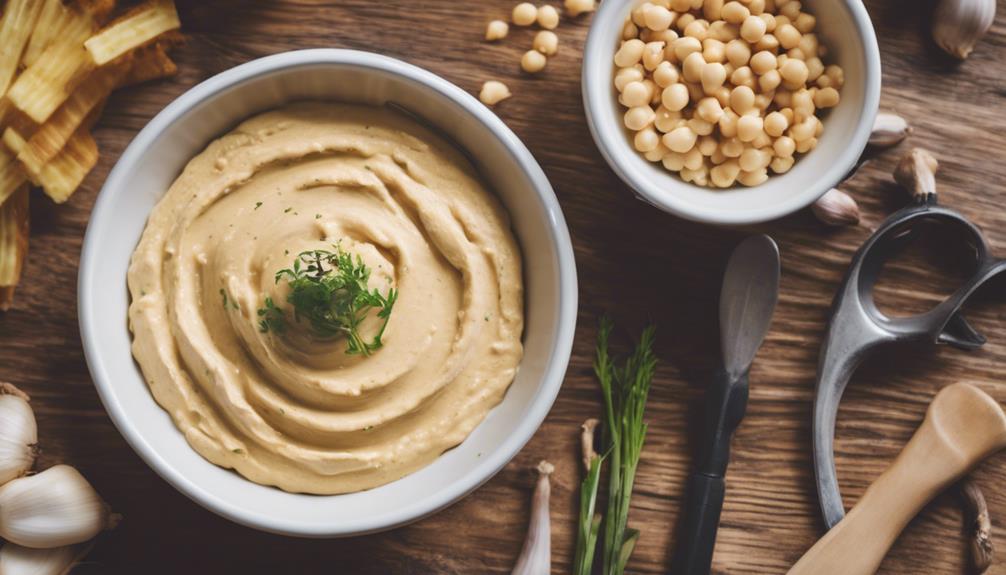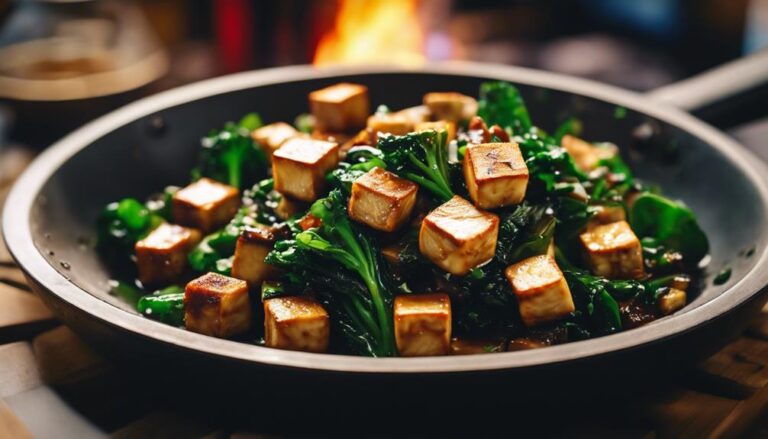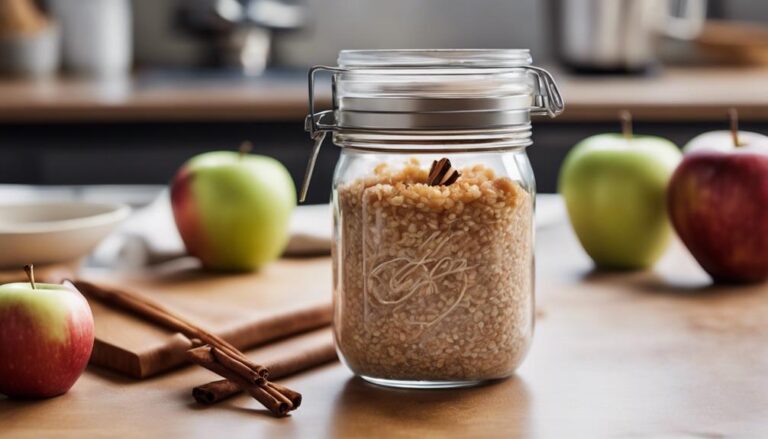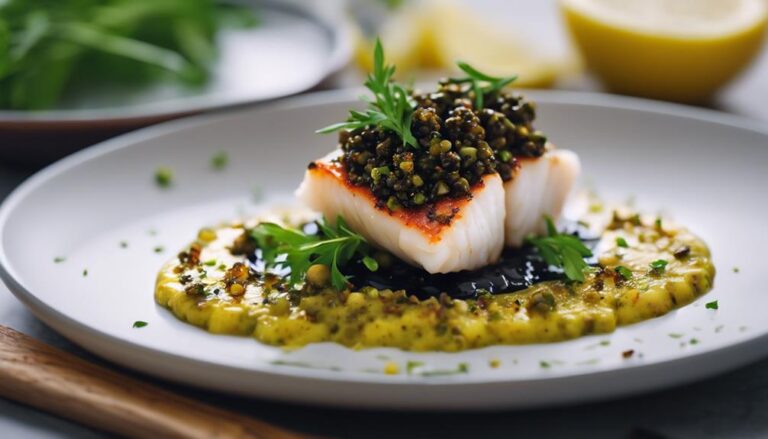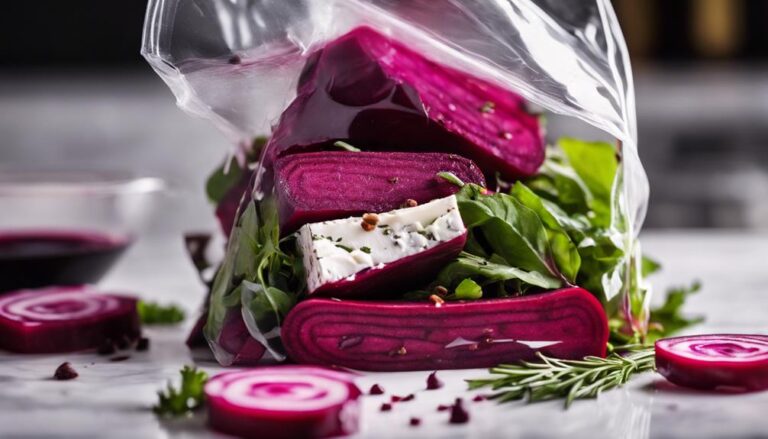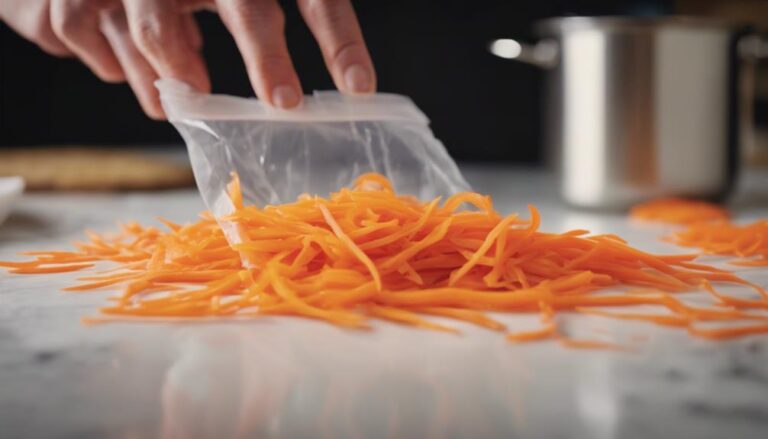Homemade Hummus With Sous Vide Garlic
Create a rich homemade hummus by infusing sous vide garlic for an elevated taste experience. Begin with traditional hummus ingredients: chickpeas, tahini, lemon juice, and olive oil. Blend in sous vide garlic for an extra layer of flavor and texture. Cool the garlic before blending to achieve a smooth consistency. Experiment with ratios to customize the velvety finish to your liking. This technique enhances the mouthfeel, making the hummus a crowd-pleaser for any occasion. For further insights on enhancing your hummus game with sous vide garlic, discover more about unique hummus variations and textural enhancements.
What You Will Learn Here
- Sous vide garlic enhances hummus flavor and texture.
- Adjust garlic quantity for desired taste intensity.
- Pre-cool garlic before blending for optimal consistency.
- Experiment with blending time for silkier hummus.
- Combine sous vide garlic with traditional hummus ingredients for a unique twist.
Hummus Origins
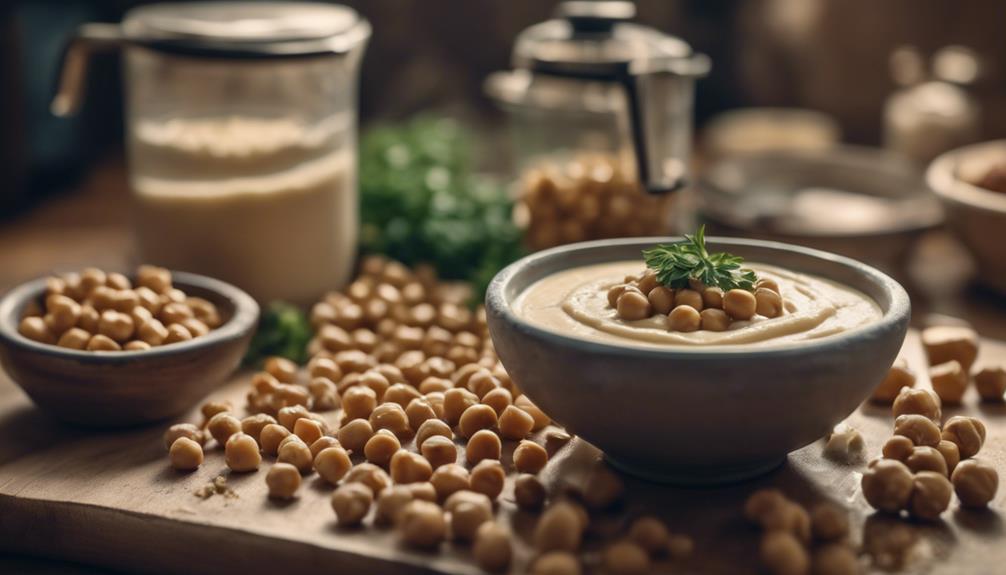
Hummus has deep historical roots, originating as a Middle Eastern staple.
It's renowned for its popular health benefits, making it a nutritious and delicious choice for many.
With its humble beginnings and widespread appeal, hummus continues to be a beloved dish enjoyed by people around the world.
Historical Hummus Roots
Tracing back to ancient times, the origins of this beloved dip can be found in the region of the Eastern Mediterranean. Hummus holds a special place in various cultures, known for its versatility and cultural significance. This creamy blend of chickpeas, tahini, lemon, and garlic offers a delightful mix of flavors that can vary with regional influences. From the zesty kick of lemon in Lebanese hummus to the smoky undertones of cumin in Egyptian varieties, each region brings its own unique twist to this classic dish.
The roots of hummus date back centuries, with evidence of its consumption by ancient civilizations. Initially created by blending simple ingredients like chickpeas and sesame paste, hummus has evolved into a staple dish enjoyed worldwide. Its popularity transcends borders, making it a symbol of communal dining and shared heritage. Whether paired with fresh vegetables, warm pita bread, or used as a flavorful spread, hummus continues to captivate taste buds with its rich history and diverse flavor profiles.
Middle Eastern Staple
As you explore the origins of hummus, you'll discover its deep-rooted connection to the Middle Eastern culinary landscape. Hummus, a versatile dish, has various regional varieties and continues to undergo innovation, adapting to modern tastes while preserving its traditional roots. This creamy spread, made primarily from chickpeas, tahini, lemon, and garlic, holds significant cultural importance in Middle Eastern cuisine. It's commonly served as a dip or a spread, accompanying dishes like falafel, kebabs, or pita bread.
The cultural significance of hummus extends beyond its ingredients; it symbolizes hospitality, togetherness, and sharing in Middle Eastern communities. Today, hummus has garnered global appeal, becoming a beloved staple in many households worldwide. Its rise in popularity can be attributed to its delicious taste, health benefits, and adaptability to various dietary preferences.
Whether you enjoy classic hummus or explore innovative flavors like roasted red pepper or spinach-infused variations, the essence of this Middle Eastern staple remains intact, bridging cultures and palates across the globe.
Popular Health Benefits
Given the nutritional profile of this popular dish, hummus boasts a range of health benefits that make it a valuable addition to any diet. Hummus is rich in protein, fiber, and various essential nutrients like iron, folate, phosphorus, and B vitamins. These nutritional benefits contribute to improved digestion, increased satiety, and better overall health. The protein in hummus can help repair and build tissues, while the fiber aids in digestive health and helps control blood sugar levels.
Furthermore, the culinary uses of hummus extend beyond a simple dip. It can be used as a spread on sandwiches or wraps, a topping for salads, or a flavorful sauce for roasted vegetables. By incorporating hummus into your meals, you can elevate the nutritional content of your dishes while enjoying its creamy texture and savory taste. Whether you're looking to boost your protein intake, increase your fiber consumption, or simply add more flavor to your meals, hummus is a versatile and nutritious option worth exploring.
Standard Hummus Components
To make standard hummus, gather chickpeas, tahini, lemon juice, garlic, olive oil, and salt.
- Chickpeas: The key ingredient in hummus, chickpeas provide a nutty flavor and creamy texture when blended.
- Tahini: This sesame paste adds a rich, earthy taste to the hummus, enhancing its flavor profile.
- Lemon Juice: Fresh lemon juice gives the hummus a tangy kick, balancing the creaminess of the chickpeas and tahini.
- Garlic and Olive Oil: These ingredients contribute to the hummus's aromatic qualities and smooth consistency, allowing you to adjust the flavor to your liking.
When making hummus, consider your flavor profiles and texture preferences. Experiment with ingredient substitutions and creative presentations to tailor the hummus to your taste. Whether you prefer a garlicky kick or a zestier lemon flavor, adjusting these components can elevate your standard hummus recipe to suit your unique preferences.
Unique Hummus Variations
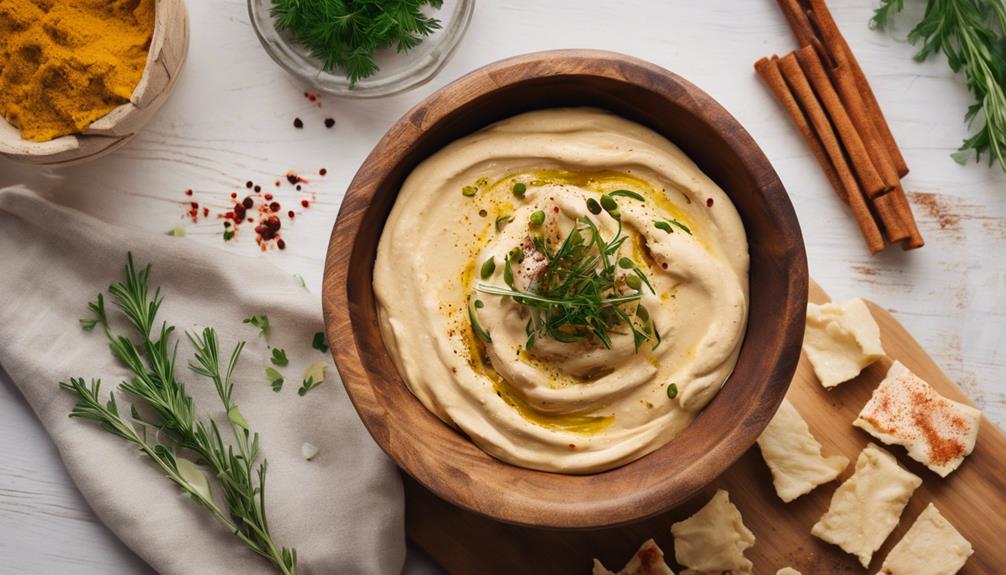
Looking to switch up your hummus game? Try out some unique variations like a garlic-infused recipe for extra flavor, a roasted red pepper hummus for a smoky touch, or a sesame seed hummus variant for a nutty twist.
These creative options can add a new dimension to your traditional hummus spread, perfect for impressing guests or simply treating yourself to something different.
Experiment with these variations to find your favorite and elevate your snacking experience.
Garlic-Infused Hummus Recipe
For a unique twist on traditional hummus, infuse it with garlic using this simple recipe. Start by roasting garlic cloves to bring out their rich and mellow flavor. Then, employ the sous vide technique to create perfectly tender garlic that will blend seamlessly into your hummus. Follow these steps to make your garlic-infused hummus:
- Roast the Garlic: Preheat your oven, wrap whole garlic heads in foil with a drizzle of olive oil, and let them roast until soft and caramelized.
- Prepare the Sous Vide Garlic: Place peeled garlic cloves in a vacuum-sealed bag with olive oil, salt, and any desired herbs. Cook in a sous vide water bath until the garlic is tender.
- Make the Hummus: Blend cooked chickpeas, tahini, lemon juice, and a pinch of salt in a food processor. Add the roasted and sous vide garlic for a flavorful twist.
- Serve and Enjoy: Drizzle with olive oil, sprinkle with paprika, and pair with your favorite dippers for a delicious garlic-infused hummus experience.
Roasted Red Pepper Hummus
After experimenting with garlic-infused hummus, explore a vibrant twist on the classic dip by incorporating roasted red peppers into your homemade hummus recipe.
- Roasted Pepper Twist: Roasting red peppers brings out their natural sweetness and adds a smoky depth to your hummus, elevating its flavor profile.
- Hummus Dip Variations: Adding roasted red peppers not only enhances the taste but also gives your hummus a beautiful reddish hue, making it visually appealing for gatherings.
- Balanced Flavor: The roasted peppers provide a perfect balance to the creamy texture of the hummus, creating a harmonious blend of flavors that will tantalize your taste buds.
- Versatile Usage: This roasted red pepper hummus can be enjoyed as a dip for pita chips, spread on sandwiches, or even used as a flavorful topping for grilled meats and vegetables.
Give this roasted red pepper hummus a try to experience a delightful twist on the traditional hummus that's sure to impress your friends and family at any gathering.
Sesame Seed Hummus Variant
Elevate your hummus game by infusing it with the rich nuttiness of sesame seeds, creating a unique variant that will add depth and complexity to this beloved dip. Sesame seed recipes offer a delightful twist to traditional hummus, enhancing its flavor profile and texture. Here's how you can take your hummus to the next level with sesame seeds:
- Toasted Sesame Seeds: Lightly toast sesame seeds before incorporating them into your hummus for a more intense nutty flavor.
- Sesame Oil Infusion: Drizzle a bit of sesame oil into your hummus mixture to amplify the sesame essence and add a silky finish.
- Sesame Seed Garnish: Sprinkle whole sesame seeds on top of your hummus for a visually appealing presentation and an extra crunch.
- Sesame Tahini Blend: Combine sesame tahini with your hummus ingredients for a double dose of sesame flavor that will elevate the taste experience.
Experiment with these hummus flavor combinations to discover a new favorite dip that will impress your taste buds and guests alike.
Enhancing Hummus Texture
To achieve a creamier hummus texture, consider adding a bit more tahini or olive oil during the blending process.
This extra fat contributes to a silky smooth consistency that enhances the overall mouthfeel of your hummus.
Experiment with different ratios to find the perfect balance for a velvety finish that will elevate your homemade hummus to a whole new level.
Creamier Hummus Texture
For a creamier hummus texture, consider blending the chickpeas longer until they reach a smoother consistency. To achieve this, you can add a bit more olive oil or a splash of cold water while blending. These essential tips can help elevate the texture of your hummus to a velvety finish. Additionally, experimenting with different flavor combinations like roasted red pepper, roasted garlic, or even a touch of cumin can add depth to the overall taste while contributing to the creamier texture.
Texture tricks can also play a crucial role in enhancing the creaminess of your hummus. Adding a bit of Greek yogurt or tahini during blending can create a silkier and smoother texture. For presentation ideas, consider drizzling some extra virgin olive oil on top, sprinkling paprika or sumac for a pop of color, or adding a few whole chickpeas for texture contrast. These simple additions can't only enhance the visual appeal of your hummus but also contribute to a creamier mouthfeel that complements the rich flavors.
Silky Smooth Consistency
Consider incorporating a dollop of Greek yogurt into your hummus recipe for a velvety smooth texture that enhances the overall consistency. This addition not only elevates the creaminess of the dip but also provides a rich, luxurious mouthfeel that will make your hummus stand out as a smooth spread.
Greek yogurt, with its thick and creamy texture, blends seamlessly with the chickpeas, creating a harmonious mixture that's easy to spread and delightful to dip. The tangy undertones of the yogurt add a subtle complexity to the hummus, enhancing its flavor profile while maintaining a silky smooth consistency that's sure to impress.
To achieve the perfect silky smooth hummus, start by adding a spoonful of Greek yogurt to your food processor along with the chickpeas, tahini, lemon juice, and garlic. Blend until velvety smooth, adjusting the ingredients as needed to reach the desired texture. The result will be a luscious, creamy dip that's perfect for any occasion.
Velvety Mouthfeel
Enhance the texture of your homemade hummus by focusing on achieving a velvety mouthfeel that will elevate your dip to a new level of creaminess. To create a velvety hummus, make certain your chickpeas are blended to a smooth consistency. The key to achieving that creamy texture lies in the process of blending your ingredients thoroughly. Make sure to incorporate the right amount of tahini and lemon juice for a balanced flavor profile while contributing to the smoothness of the hummus.
When using the sous vide garlic technique in your hummus recipe, you're not only enhancing the flavor but also adding a luxurious mouthfeel. The garlic becomes tender and infuses its essence into the hummus, further contributing to its velvety texture. Be sure to let the garlic cool before incorporating it into the blend to prevent unwanted heat from affecting the overall consistency of your hummus.
Final Thoughts
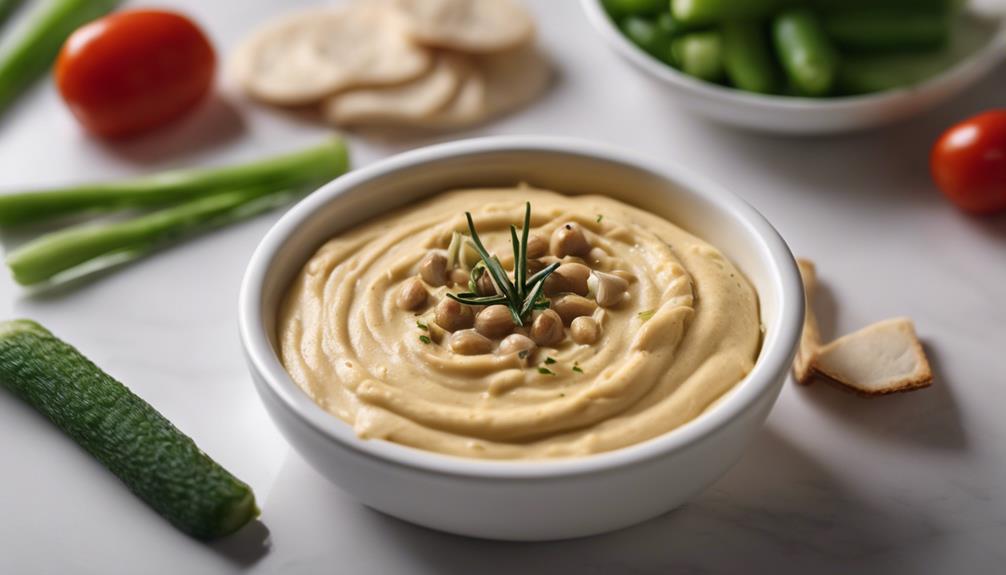
To wrap up your homemade hummus journey with sous vide garlic, reflect on the textures and flavors you have experienced throughout this culinary adventure. As you ponder the velvety mouthfeel achieved through the sous vide garlic infusion and the creamy smoothness of the chickpeas, take a moment to appreciate the magic of culinary techniques coming together in harmony.
The reflection on this flavorful creation allows you to appreciate the intricate balance of ingredients and methods that have led to a hummus that surpasses store-bought varieties. The sous vide garlic, with its mellow yet robust essence, has elevated the hummus to new heights, adding layers of complexity that tantalize the taste buds.
In your final thoughts, consider how this homemade hummus with sous vide garlic hasn't only satisfied your palate but also deepened your understanding of how culinary techniques can transform simple ingredients into extraordinary dishes. Embrace the joy of creating something delicious from scratch and savor every moment of this flavorful journey.
Frequently Asked Questions
Can I Use Pre-Peeled Garlic for Sous Vide Garlic?
Yes, you can use pre-peeled garlic for sous vide garlic. It's convenient, but fresh garlic offers more health benefits. Guarantee proper sealing to prevent garlic from floating. Experiment with timing and temperatures for best results.
How Long Can I Store Homemade Hummus in the Fridge?
For homemade hummus, store in the fridge for up to a week. To keep it fresh, cover tightly and stir before serving. Try different hummus variations like adding roasted red peppers or herbs. Consider ingredient substitutions for unique flavors.
Is It Necessary to Soak Chickpeas Overnight for Hummus?
For quick preparation, soaking chickpeas overnight isn't necessary for hummus. You can use canned chickpeas for a convenient option. Experiment with flavor variations like roasted red pepper or sun-dried tomato to customize your hummus.
Can I Substitute Tahini With Another Ingredient in Hummus?
If you run out of tahini for hummus, try almond butter or Greek yogurt. Each gives a unique flavor twist. Adjust according to your texture preference. Get creative with homemade dips, exploring endless flavor variations.
What Other Dishes Can I Pair With Homemade Hummus?
Pair your homemade hummus with pita bread, fresh veggies, or crackers for a delicious snack or appetizer. Explore hummus variations like roasted red pepper or avocado hummus. Try different dips like tzatziki or baba ganoush for tasty pairings.
Conclusion
To sum up, homemade hummus with sous vide garlic offers a unique twist on a classic dish, adding depth of flavor and a creamy texture.
By exploring different variations and techniques, you can elevate your hummus game and impress your friends and family with your culinary skills.
Experiment with ingredients and cooking methods to find the perfect combination that suits your taste preferences.
Enjoy the process of creating and tasting different hummus recipes to discover your favorite flavors.
